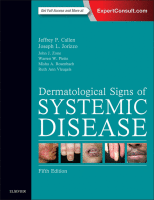Physical Address
304 North Cardinal St.
Dorchester Center, MA 02124

Key Points Dermatologic adverse events (AEs) of cancer therapies can cause patient discomfort and impair their quality of life, increase the cost of medical care, and even result in dose modifications, all of which can negatively impact clinical outcomes. The…

Key Points Curth’s postulates provide a group of criteria that are helpful to determine whether a skin condition is likely to be related to an internal malignancy. Individual paraneoplastic skin conditions tend to be associated more frequently with certain types…

Key Points Immunobullous diseases are a complicated multisystem management challenge requiring advanced immunosuppressive regimens. Pathogenesis has been linked to disease-specific autoantibodies to structural antigens within the epidermis and basement membrane zone. The location of blistering, risk of subsequent scarring, and…

Key Points Purpura has an extended and complex differential diagnosis, but can be sorted into three main pathophysiologies: simple hemorrhage, inflammatory (vessel-directed) hemorrhage, and microvascular occlusion. Recognition of patterns of morphology, number and distribution can rapidly narrow the diagnostic possibilities…

Key Points Erythroderma is erythema, with or without scaling, involving more than 90% of the cutaneous surface. Many cases of erythroderma are idiopathic, but the most common causes are exacerbation of an underlying skin disease, a drug hypersensitivity reaction, and…

Key Points Chronic itch can occur without primary skin rash associated with underlying systemic diseases. Itch can be the presenting symptom of lymphoma and hepatic diseases. Chronic systemic itch is associated with imbalance of μ versus κ opioids. Topical antipruritic…

Key Points The panniculitides comprise a heterogeneous group of inflammatory diseases that involve the subcutaneous fat. Various panniculitides may show the same clinical appearance, consisting of erythematous nodules, which frequently makes histopathologic study necessary in order to obtain the specific…

Key Points Herpes simplex virus infection is a frequent cause of erythema multiforme, while drugs most often cause Stevens–Johnson syndrome and toxic epidermal necrolysis. Erythema multiforme is often self-limited, skin lesions often target-appearing, and mucosal lesions can occur in the…

Key Points Urticaria is characterized by development of wheals and/or angioedema of the skin or mucosa. Individual lesions have a transient nature lasting less than 24 hours. Infection, drugs, chemicals, foods, inhalants, contactants, and physical stimuli are several recognizable triggers…

Key Points Peripheral blood eosinophilia provides clues to diagnosis, but it is not a diagnostic marker except when levels of peripheral blood eosinophils are in the “hypereosinophilic” range as found in the hypereosinophilic syndromes. Many diseases with increased peripheral blood…